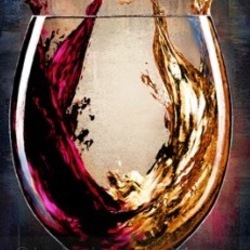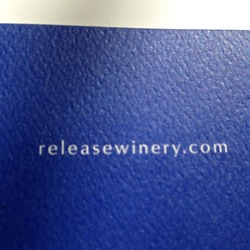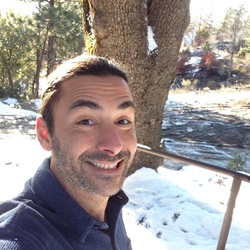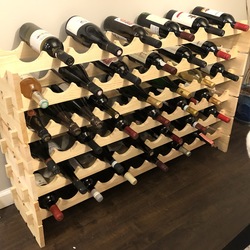Aujoux Négociant
Château Lynch-Moussas
Pauillac Red Bordeaux Blend 1996
Whatever words I would use to describe how amazing the 96 was with our Prime Rib Roast last night would simply fall short & never do it justice.
The evolution that took place in this bottle after 21 years was never conceived by anyone tasting it upon release or young. It has made a epic leap and simply heaven on the palate.
Oh...as a friend of mine was always fond of saying...”The Prime Rib Roast didn’t suck either!”
I wanna do this again real soon. OMG!!!
Still processes me this morning.
Recent purchase that was a direct import from the Chateau - Négociant
Happy New Year! 🎊🎆🎈🍷🍾🥂 — 6 years ago

Domaine Henri Boillot
Clos de la Mouchère Monopole Puligny-Montrachet 1er Cru Chardonnay 2013
One the nose, a touch of sour green apple, lime zest, ripe pineapple, mango, lemon, touch of mint, stone fruit skin, honey, green melon, limestone minerals, sea shells, yellow lilies & spring flowers.
The palate is thick and rich from a touch extra lees stirring. A touch of sour green apple, lime zest, ripe pineapple, mango, lemon, touch of mint, stone fruit skin, honey green melon, limestone minerals, sea shells, yellow lilies & spring flowers. Good round acidity with a long rich finish that lasts minutes.
Photos; Puligny-Montrachet -Clos de la Mouchere, owner/Winemaker Henri Boillot and their Domaine.
Producer notes & history... Before striking out on his own in 1984 Henri had worked for the family firm but his success in his own right persuaded his grandfather Jean Boillot to persuade him to return to the fold. In 2005 Henri bought out his brother and sister and renamed the domaine name from Domaine Jean Boillot to Domaine Henri Boillot to avoid confusion with his brother Jean-Marc Boillot's company.
The Domaine consists of some 19 hectares, mostly in Puligny and Meursault for white wines where he owns the monopole of Clos de la Mouchere, and in Savigny-les-Beaunes, Beaune and Volnay for reds.
In the vineyard Henri and Guillaume farm sustainably, avoiding artificial pesticides and herbicides, and much hard work in the vineyard means low yields of relatively late-picked fruit at a peak of ripeness. The whites are very gently crushed to avoid bitter flavours and fermented in barrels larger than the norm at 350 litres so that the purity and freshness of the fruit is unencumbered, and bottling follows 18 months or so in barrel. Pinot noir grapes are sorted in the vineyard before being taken to the winery, destemmed, crushed and cold soaked before a fairly long fermentation. 18 months in barriques is the norm before being bottle unfined and unfiltered.
Since 2006, he has worked with his son Guillaume, who now makes the red wines, at their new state-of-the-art winery in Meursault where all the Domaine and 'négociant' wines (under the label of Maison Henri Boillot) are made. — 8 years ago
Domaine Leroy
Bourgogne Pinot Noir 2015
On the nose, nicely concentrated wild dark berries, black plum, notes of blue fruits, vanilla, understated cinnamon, soft, warm spices, Christmas cake and fresh dark, fragrant florals. The mouthfeel is rich & concentrated. The fruits dark are clearly fresh & ripe. Wild dark berries, black plum, plum, dark cherries, poached strawberries, black raspberries, Thompson raisins, light vanilla, soft warm spices, limestone minerals, grainy/silky chalkiness, dark moist soils, crushed rocks, violets, fresh dark florals, touch of mint, beautiful round acidity and amazing long rich beautiful finish that is well balanced fruit & earth. This is a vintage (even though Bourgogne) will cellar around 20 years. My rating could jump 2-3 points with proper storage years in the cellar. It's tasting more like 1st Cru than village wine. Photo tour of the estate, open top fermenters (I believe they ferment all their lots separately) and Lalou Bize-Leroy singing and talking to her precious vines. Producer history and notes...Domaine Leroy is arguably producing the greatest red Burgundy wines in the Cote d`Or at present. Lalou Bize-Leroy started out as a négociant, working for her family's Maison Leroy, which was founded by her father Henri. There are three parts to the Leroy empire; the Maison Leroy based in Auxey-Duresses, Domaine d’Auvenay and substantial holdings in Vosne-Romanée. Lalou Bize-Leroy also owns 25% of Domaine de la Romanée-Conti, where she was co-director until the other shareholders ousted her in 1992, partly because she had started a competing winery. Domaine Leroy has been farmed biodynamically from the start and is now certified by ECOCERT. The other exciting, if not controversial, move was the change in training system for the vines. For some time previously the hedging (rognage) of the vineyards had been done by hand rather than more abrasively by machine. However, it is not natural for the vine to be cut back as it affects the vine’s performance both in the current season and the following year. So now, after the flowering, when the shoots are lengthening, they are curled over instead of being cut back. This minimises entrecoeurs and second crop bunches forming, as well as leaving the vine happier and healthier. She also talks and sings to her vines daily. She believes this promotes health of the vines and who could argue with her given what she puts in the bottle. Lalou Bize-Leroy has 23 hectares of vines, mostly Premier and Grand Cru classified. In the vineyard, Lalou practices biodynamism as well as severe pruning and crop-thinning. The result is ridiculously low yields. Yield arguments at DRC were also an issue in her departure. You want to buy this wine. $39.99 at K&L Wine Merchants on pre-arrival. Just bought four bottles.
— 8 years ago
Satellite
Côtes de Bordeaux Red Bordeaux Blend 2017
2017 vintage. Satellite Wines is the négociant company started by enfant terrible Olivier Techer, owner of Pomerol estate Château Gombaude Guillot and the brains behind "Pom'n Roll", shaking up the region. The idea is to highlight lesser-known parts of Bordeaux, like this serious organically farmed Côtes de Bordeaux. Not sure if this is a pure Merlot or a blend, but it is undoubtedly a very good wine. Concentrated fruit, a serious tannic structure, balanced acidity and good length. The label states "Bordeaux à boire", but actually this has a very classic ageworthy feel about it, giving many Saint-Emilions a run for their money. Should be perfect in 2 years time, but highly enjoyable now. Very good value at 15 euro. Even better the next day. Abv. 13,5%. — 5 years ago
Hinterland
L’imparfait Négociant Chardonnay 2017
Normandy cider, motts apple sauce, linear acidity.
Zev Rovine selections. — 6 years ago
Hospices de Beaune
Cuvée Clos des Avaux Beaune 1er Cru Pinot Noir
cold weather ❄️ calls for hearty food, which calls for boeuf bourguignon🥘 , which calls for good red #Burgundy🍷 , which called up this fine, floral, minerally #Pinot (Beaune 1er Cru Clos des Avaux '05 🇫🇷) made from barrels purchased by the great #GeddyLee 🎸 🇨🇦 at the Hospices de Beaune auction ⛪ & vinified by boutique Burgundy négociant Lucien La Moine - #WineWednesday #wine #Burgundy #RUSH #Beaune — 8 years ago
Jacques Depagneux
The Society's Beaujolais-Villages Gamay
From the Wine Society: This is the source of the bulk of our Beaujolais for the last 50 years, and many members will also have tried the fruits
of The Society’s work with this excellent Beaujolais-based négoce in the form of our bestselling white wine, The
Society’s White Burgundy, sourced from the Mâcon.
Dealing with a négociant allows The Wine Society to pick and choose, often blending together from different estates in
order to end up with a wine that is better than any of its parts.
Négoces have had a huge part to play in the recent history of Beaujolais, some of it not so good but some of it very
positive. For all its apparent simplicity, Beaujolais is a complicated region that is often the victim of its own capricious
climate with late frosts and violent hailstorms a common recurrence.
The one name that stands out for us is Dépagneux: Jean Dépagneux was the last of this illustrious merchant family
who, with his partners, bought up a list of ailing names such as Aujoux, which had made its name selling Beaujolais to
the once profitable Swiss market. Jean retired about a dozen years ago and his place was taken by a young and
talented oenologist from Viré called Jean-Marc Darbon. One consequence of the change has been the meteoric rise in
the quality of The Society’s White Burgundy. — 8 years ago
Louis Latour
Corton Grand Cru Pinot Noir 2001
On the nose; poached strawberries, cherries, bing cherries, cooked rhubarb, dry cranberries, faint spice, light vanilla, limestone and fresh red florals. The mouthfeel is lean to medium and very juicy. Tannins completely resolved. Strawberries, cherries, bing cherries, cooked rhubarb, dry cranberries, cola, steeped tea, faint spice, limestone minerals, loamy soils, faint spice, touch of vanilla, herbal notes, soft high acidity and lean, elegant, long, fruit finish. Even though this was likely a little better two years ago, it's good but certainly a little disappointing for Grand Cru Burgundy. History notes...the Louis Latour family first bought vines in the Cote de Beaune in 1731, with land in some of the top Burgundy vineyards. Louis Latour is currently run by the seventh Louis Latour, Louis-Fabrice Latour featured in the photo. They are a huge négociant with property holdings in Aloxe-Corton (their largest holdings) and Corton-Charlemagne. They also own parts of Corton Clos de la Vigne au Saint Grand Cru, Corton Bressandes Grand Cru, Corton Les Chaumes Grand Cru, Corton Les Pougets Grand Cru, Corton Les Perrières Grand Cru, Corton Clos du Roi Grand Cru, Corton Les Grèves Grand Cru. Also, own parts of the Premiers Crus“Les Chaillots”, “Les Founières”, Chambertin, Romanée-Saint-Vivant and Chevalier-Montrachet “Les Demoiselles." They use French oak vats for short period of fermentation on nearly all their red wines. Then...they spend 12 months in French oak barrels. The red wines of Domaine Louis Latour are still vinified and aged at Corton Grancey featured in the photo. — 8 years ago
North Park Urban Winery
Négociant Borden Ranch Barbera 2014
Tasty new world barbera — 9 years ago
Les Vins Aujoux
Moment de Plaisir Cinsault Grenache Rosé
Very refreshing and light — 5 years ago
Les Vins Aujoux
Moment de Plaisir White Blend 2019
Kevin loved it! — 6 years ago
Louis Jadot
Domaine Gagey Les Drazeys Chambolle-Musigny Pinot Noir 2015
The French Revolution detonated everything about the old order of France, and wine was no exception - far from it. The great vineyards of Burgundy, that had been tended to and ached over by Benedictine and Cistercian monks for centuries, were confiscated and auctioned off to the petite bourgeoisie in Paris and Dijon. The Napoleonic inheritance code, which guaranteed an even split between all children, led to these ancient plots being further divided up with each passing generation.
It wasn't long before there was a multitude of disinterested Parisians who owned a few vines in the Cote d'Or as their birthright. Négociant houses, such as Louis Jadot, popped up to make deals with these small landholders, aggregate their scattered plots, and bring their wine to the world.
Modern Burgundy is still very much a reflection of its transformation during the Revolution, with some of the world’s most famous and valuable land portioned out into tiny parcels. It’s no wonder demand outstripped supply long ago!
(This is adapted from notes for Le Dû’s Wines ‘History of Wine 1453AD-Present’ seminar, where this wine was poured) — 6 years ago
Jean-Marc Aujoux
Fleurie Belle Grace Gamay 2013
Very good red - 100% gamay — 8 years ago
Château Canon
Saint-Émilion Red Bordeaux Blend 1986
We were suppose to be in Napa this weekend. Sadly, no one should be in Napa/Sonoma except Firefighters and first responders. However in lieu of; the Sodhani party, appointments at Beau Vinge, Mark Herold & a steak at Cole’s Chop House, what the next best thing? #STEAKANDCLARETNIGHT at home in the backyard. This 86 was amazing with my ribeye. The kind of pleasure that causes great pause and rolls the eyes a bit. On the nose; menthol, eucalyptus, dry herbs, soft ripe blackberries, dark cherries, strawberries, baked plum, perfectly stated baking spices, stones, soft unstated spice, clay, rich dark earth, touch of black cherry cola and fresh & dark florals. The palate is heaven as it coats. The body medium full, layered and the tannins are nicely resolved but not completely...still a fair amount of life in this bottle. I’d say it’s still around it’s peak. The fruits are ripe and still fresh. Blackberries, baked plum, dark cherries, strawberries, dry cranberries, hues of blueberries, black cherry cola, sweet darker spice, vanilla, clove, nutmeg, cinnamon, dark rich earth, dry stones, tobacco, suede leather, dry clay, menthol, eucalyptus, touch of dry herbs, fresh & dry dark flowers, beautiful, round acidity, perfect 12.5% alcohol and a long, even, elegantly balanced with beautiful structure, tension & length that’s lasts two minutes. It’s in a really excellent spot. 9.6 with the ribeye and 9.4 on it’s own. Photos of; an aerial shot of Chateau Canon, owners Alain and Gerard Wertheimer who made their first big money on Chanel, own Rauzan-Segla and are worth just under a paltry 10 billion, their barrel room and their Saint-Emilion vineyard. Producer notes and history...Chateau Canon is a premier cru with a history of fine vintages. This Saint-Emilion property has long been recognised as one of the best in the appellation. It is believed that Canon was named after Jacques Kanon, the naval officer who bought estate in 1760. He built the château here and surrounded it with plantings solely of vines...a rare agricultural practice at the time. However, he then sold the estate to a Bordeaux négociant just ten years later. In 1919 it was purchased by the Fournier family, who owned the property until 1996. When they sold it to the Wertheimer family, owners of Chanel and of Rauzan-Ségla in Margaux it unfortunately had some serious problems. The cellars were contaminated with TCA, the chemical compound which causes cork taint. Many of the vines were infected by viruses and in need of being replaced. As well, part of the vineyard above the quarried cellars had subsided. Fortunately the Wertheimers had the money to fix these issues and a manager, John Kolasa with the skills. The first decade of the 21st century saw Canon begin to regain its reputation once John Kolasa retired and Nicolas Audebert at Rauzan-Ségla took over. The substantial estate covers 22 hectares on Saint-Emilion’s famous limestone plateau close to the town. The vines have an average age of 25 years and are generally planted with a southerly or south-westerly exposure. 75% of the vines are Merlot and 25% Cabernet Franc. After the grapes are hand-picked, they are fermented in traditional cone-shaped vats, before spending 18 months ageing in oak barrels, 50% new and 50% used. — 8 years ago


North Park Urban Winery
Négociant Dry Creek Valley Petit Sirah 2012
Petite sirah- sierra foothills California — 8 years ago










Stefan Dolhain
2009 vintage. Mainly Cabernet Sauvignon (71,5 %), with Merlot (25%) and Petit Verdot (3,5%). Property of Patrick Bernard (also owner of Bordeaux négociant Millésima and cousin of Olivier Bernard who owns Domaine de Chevalier). — 5 years ago